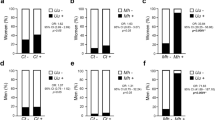Abstract
Purpose
To determine the prevalence of positive test for Ureaplasma urealyticum (UU), Mycoplasma hominis (MH), Chlamydia trachomatis (CT), Neisseria gonorrhoeae (NG) infections, and their corresponding Rubella status when undergoing workup for infertility.
Methods
Retrospective chart review to determine infection status for UU, MH, CT, and NG as determined by cervical swab, as well as the serum Rubella antibody titer.
Results
A total of 46 patients of the patients reviewed were positive for UU (20.1%), three patients were positive for MH (1.3%), five patients were positive for CT (2.2%) and one patient was positive for NG (0.4%). Rubella immunity was confirmed in 90.3% of patients.
Conclusion
Approximately one quarter of women presenting to an infertility clinic seeking to conceive were found to have a positive test for UU, MH, CT or NG infection. Additionally, almost 10% of the patients were Rubella non-immune at the time of presentation for infertility evaluation.

Similar content being viewed by others
References
Webster LA, Greenspan JR, Nakashima AK, Johnson RE. An evaluation of surveillance for Chlamydia trachomatis infections in the United States (1987–1991). MMWR CDC Surveill Summ 1993;42:21–7.
Quinn TC, Zenilman J, Rompalo A. Sexually transmitted diseases: advances in diagnosis and treatment. Adv Intern Med 1994;39:149.
Alexander LA, Cates JR, Herndon N, Ratcliff JM. Sexually transmitted diseases in America. Menlo Park, CA: Kaiser Family Foundation; 1998. December.
Miller WC, Ford CA, Morris M. Prevalence of chlamydial and gonococcal infections among young adults in the United States. JAMA 2004;291:2229.
Hillis SD, Joesoef R, Marchbanks PA, Wasserheit JN, Cates W, Westrom L. Delayed care of pelvic inflammatory disease as a risk factor for impaired fertility. Am J Obstet Gynecol 1993;168:1503–9.
Cates W Jr, Wasserheit JN. Genital chlamydial infections: epidemiology and reproductive sequelae. Am J Obstet Gynecol 1991;164:1771.
World Health Organization Task Force on the Prevention and Management of Infertility. Tubal infertility: serologic relationship to past chlamydial and gonococcal infection. Sex Transm Dis 1995;22:71.
Harger JH, Archer DF, Marchese SG, Muracca-Clemens M, Garver KL. Etiology of recurrent pregnancy losses and outcome of subsequent pregnancies. Obstet Gynecol 1983;62:574–81.
Stray-Pedersen B, Eng J, Reikvam TM. Uterine T-mycoplasma colonization in reproductive failure. Am J Obstet Gynecol 1978;130:307–11.
Taylor-Robinson D. Infections due to species of Mycoplasma and Ureaplasma: an update. Clin Infect Dis 1996;23:671–82.
Mardh PA, Westrom L. Tubal and cervical cultures in acute salpingitis with special reference to Mycoplasma hominis and T-strain mycoplasmas. Br J Vener Dis 1970;46:179.
Thomsen AC, Lindskov HO. Diagnosis of Mycoplasma hominis pyelonephritis by demonstration of antibodies in urine. J Clin Microbiol 1979;9:681–7.
Cassell GH, Davis RO, Waites KB, Brown MB, Marriott PA, Stagno S, Davis JK. Isolation of Mycoplasma hominis and Ureaplasma urealyticum from amniotic fluid at 16–20 weeks of gestation: potential effect on outcome of pregnancy. Sex Transm Dis 1983;10:294–302.
Witkin SS, Kligman I, Grifo JA, Rosenwaks Z. Ureaplasma urealyticum and Mycoplasma hominis detected by the polymerase chain reaction in the cervices of women undergoing in vitro fertilization: prevalence and consequences. J Assist Reprod Genet 1995;12:610–4.
Rodriguez R, Hernandez R, Fuster F, Torres A, Prieto P, Alberto J. Genital infection and infertility. Enferm Infec Microbiol Clin 2001;19:261–6.
Gump DW, Gibson M, Ashikaga T. Lack of association between genital mycoplasmas and infertility. N Engl J Med 1984;310:937–41.
Nagata Y, Iwasaka T, Wada T. Mycoplasma infection and infertility. Fertil Steril 1979;31:392–5.
McCormack WM, Rosner B, Lee Y. Colonization with genital Mycoplasmas in women. Am J Epidemiol 1973;97:240.
Taylor-Robinson D, McCormack WM. The genital mycoplasmas. N Engl J Med 1980;302:1003.
Lee YH, Rosner B, Alpert S, Fiumara NJ, McCormack WM. Clinical and microbiological investigation of men with urethritis. J Infect Dis 1978;138:798–803.
Marais NF, Wessels PH, Smith MS, Gericke A, Richter A. Chlamydia trachomatis, Mycoplasma hominis and Ureaplasma urealyticum infection in Women. Prevalence, risk and management at a South African infertility clinic. J Reprod Med 1991;36:161–4.
Best JM. Rubella Seminars in Fetal and Neonatal Medicine 2007;12:182–192
Revised ACIP recommendation for avoiding pregnancy after receiving a rubella-containing vaccine. MMWR Morb Mortal Wkly Rep 2001;50:1117.
Author information
Authors and Affiliations
Corresponding author
Additional information
Determination of ureaplasma, mycoplasma, chlamydia and gonorrheae infections as well as rubella status in patients undergoing infertility treatment is important during the initial evaluation.
Rights and permissions
About this article
Cite this article
Imudia, A.N., Detti, L., Puscheck, E.E. et al. The prevalence of ureaplasma urealyticum, mycoplasma hominis, chlamydia trachomatis and neisseria gonorrhoeae infections, and the rubella status of patients undergoing an initial infertility evaluation. J Assist Reprod Genet 25, 43–46 (2008). https://doi.org/10.1007/s10815-007-9192-z
Received:
Accepted:
Published:
Issue Date:
DOI: https://doi.org/10.1007/s10815-007-9192-z




